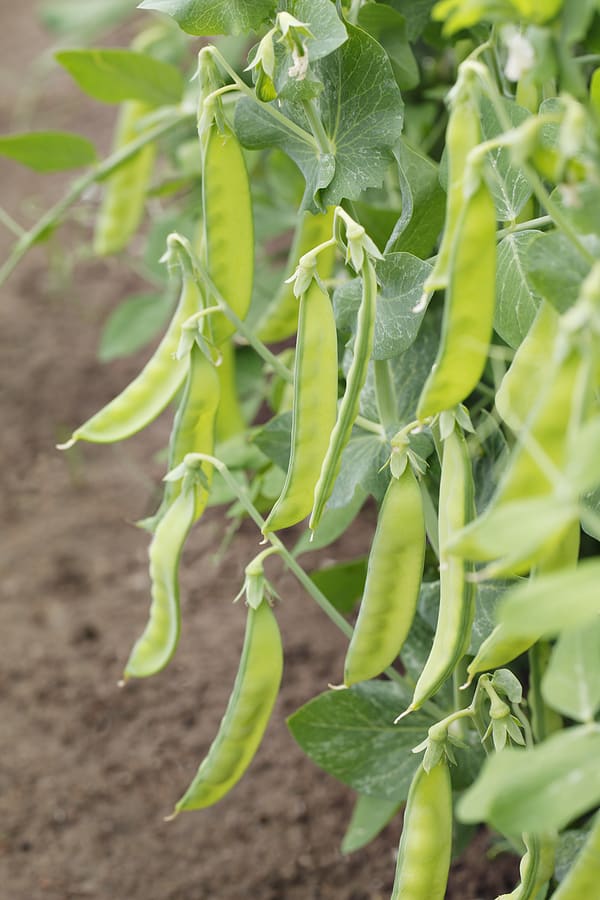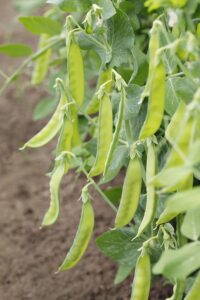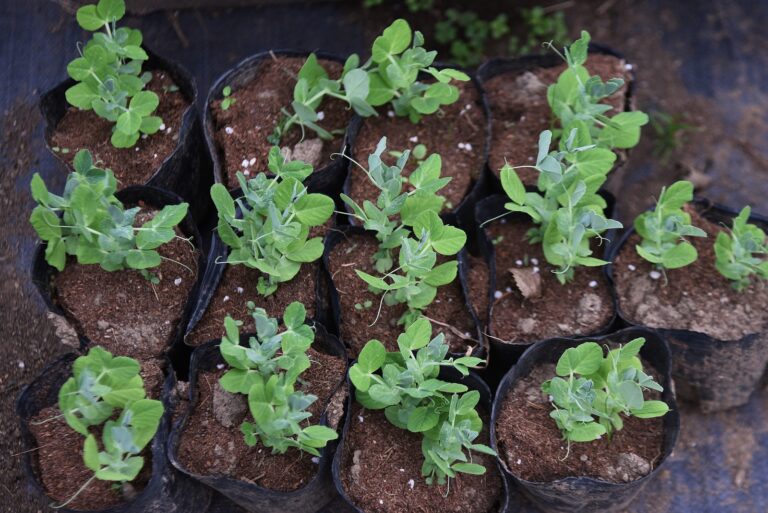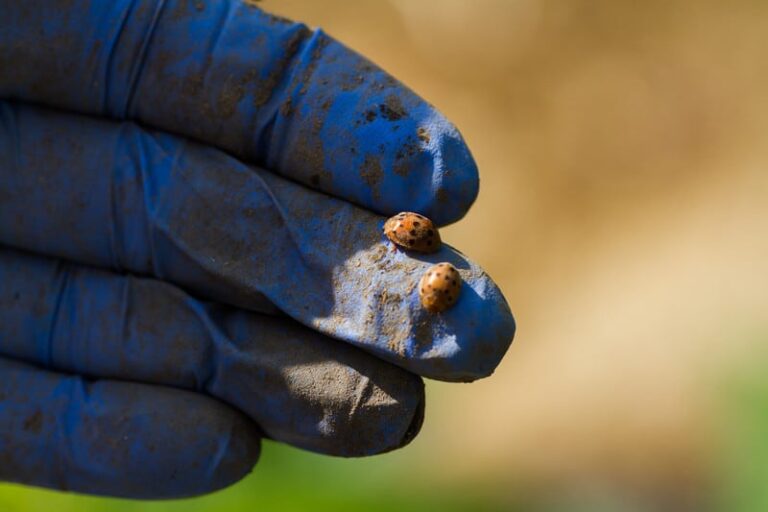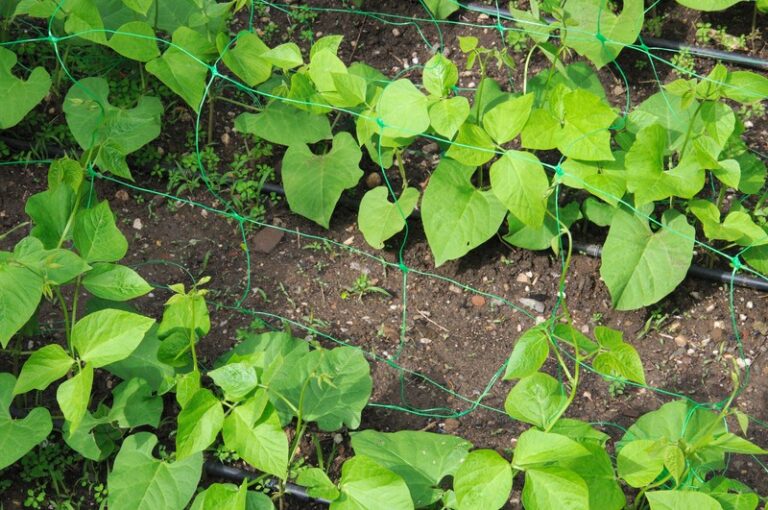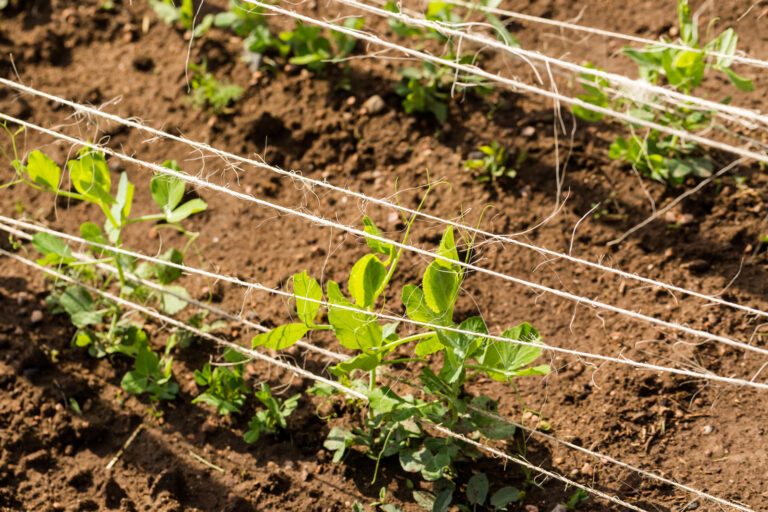Peas: Common Pests and Diseases and Their Natural Controls
Peas are generally easy to grow, but they can still fall victim to pests and diseases that reduce yield and vigor. By identifying problems early and using natural controls, you can keep your pea plants healthy and productive without resorting to harsh chemicals. Here are the most common pests and diseases to watch for and organic ways to manage them.
Common Pea Pests
Aphids
Aphids cluster on tender shoots and undersides of leaves, sucking sap and spreading viruses. Natural controls include blasting them off with a strong stream of water, introducing beneficial insects such as ladybugs and lacewings, and spraying neem oil or insecticidal soap.
Pea Weevils
Pea weevil larvae bore into developing peas, causing shriveled seeds. To prevent infestations, rotate crops yearly, avoid planting near stored peas, and use floating row covers until flowering.
Thrips
Thrips scrape plant tissue and cause silver streaks or distorted leaves. Control them with blue sticky traps, neem oil, or insecticidal soap, and encourage predatory mites.
Cutworms
Cutworms chew through young seedlings at soil level. Protect plants with cardboard collars, apply diatomaceous earth around stems, and keep the garden free of weeds and debris.
Common Pea Diseases
Powdery Mildew
This fungal disease creates a white powdery coating on leaves, slowing growth. Plant resistant varieties, space plants for good airflow, and spray with a solution of 1 tablespoon baking soda in 1 gallon of water mixed with a few drops of liquid soap.
Fusarium Wilt
Fusarium causes yellowing and wilting, often in warm soil. Rotate crops, improve drainage, and use disease-resistant pea varieties to minimize risk.
Root Rot
Poor drainage and overwatering promote root rot. Ensure soil drains well, avoid overwatering, and add compost to improve soil structure.
Pea Enation Mosaic Virus
This virus causes distorted leaves and pods. Control aphids (the primary vector), remove infected plants, and plant resistant varieties.
Natural Pest and Disease Prevention Tips
- Crop Rotation: Avoid planting peas in the same spot for at least three years.
- Healthy Soil: Add compost and mulch to boost soil health and microbial activity.
- Resistant Varieties: Choose disease-resistant pea cultivars when possible.
- Regular Monitoring: Inspect plants often and act at the first sign of trouble.
With attentive care and organic controls, you can protect your peas from pests and diseases and enjoy a healthy, abundant harvest.Fresh-picked home-grown green peas are worth the effort. The flavor of fresh-picked peas will far outdistance the flavor of store-bought peas because the flavor of peas dulls quickly after picking as sugar changes to starch.
Peas grow best in cool weather, but peas are not limited to spring planting. Late summer and fall planting can result in fall, winter, and early spring harvests in mild-winter regions. Peas are best grown on supports to keep them off the ground and away from many pests and diseases. (For pea growing tips see How to Grow Peas or Pea Growing Success Tips at the bottom of this post.)
Good Products for Pest and Disease Control at Amazon:
- Garden Safe Snail and Slug Bait
- Bonide Sulfur Fungicide
- Neem Bliss 100-% Cold Pressed Neem Oil
- PyGanic Botanical Insecticide
Here are pea growing problems with cures and controls:
Seed and seedling problems
Seedlings fail to emerge from the soil or seedlings are eaten
A cabbage maggot is a small gray-white, legless worm to ⅓-inch long; an adult looks like a housefly. Seedcorn maggot is a small, yellowish-white maggot, the larva of a small gray fly. Flies lay eggs in the soil near the seedling or plant. Apply lime or wood ashes around the base of plants; time planting to avoid insect growth cycle. Plant a bit later when the weather is drier.
Young plants are eaten or cut off near the soil level
Cutworms are gray grubs ½- to ¾-inch long that can be found curled under the soil. They chew stems, roots, and leaves. Place a 3-inch paper collar around the stem of the plant. Keep the garden free of weeds; sprinkle wood ash around the base of plants.
Seeds rot or seedlings collapse with dark water-soaked stems as soon as they appear
Damping off is a fungus that lives in the soil; it emerges where humidity is high. Do not plant in cold, moist soil. Make sure the soil is well drained. Rotate crops.
Plants stunted; vines off-color; roots rotten or absent
Root rot and crown rot. Improve soil drainage by adding aged compost to planting beds. Destroy infected plants. Rotate crops. Plant disease-resistant varieties.
Leaf problems
Leaves curl under and become deformed and yellowish
Aphids are tiny, oval, and yellowish to greenish pear-shaped insects that colonize the undersides of leaves. They leave behind sticky honeydew. Spray away aphids with a blast of water. Use insecticidal soap.
Leaves turn pale green, yellow, or brown; dusty silver webs on the undersides of leaves and between vines
Spider mites suck plant juices causing stippling. Spray with water or use insecticidal soap or rotenone. Ladybugs and lacewings eat mites.
Trails and tunnels in leaves
Leafminer larvae tunnel inside leaves. Destroy infected leaves and cultivate the garden to destroy larvae and keep adult flies from laying eggs. Cover crops with floating row covers.
Holes chewed in leaves, leaves skeletonized; runners and young fruit are scarred
Spotted cucumber beetle is greenish, yellowish, ¼ inch (7mm) long with black spots and a black head. The striped cucumber beetle has wide black stripes on the wing covers. Handpick; mulch around plants; plant resistant varieties; dust with wood ashes.
Large holes in leaves; leaves skeletonized
Armyworms are dark green caterpillars the larvae of a mottled gray moth with a wingspan of 1½ inches. Armyworms mass and eat leaves stems, and roots of many crops. Handpick caterpillars and destroy them. Cultivate after harvest to expose the pupae. Use commercial traps with floral lures.
Semicircular notches on leaf margins; holes in blossoms
Pea weevil is a brownish beetle with white and black spots to about 1/5 inch long. It feeds at night. Sprinkle diatomaceous earth or wood ashes around plants. Spray with pyrethrum.
Scorched leaf margins
Molybdenum deficiency. Test soil. If deficient in molybdenum, add one teaspoon of ammonium molybdate per 1,000 square feet.
Round to angular spots on leaves, reddish brown to black
Anthracnose is a fungus disease that spreads in high humidity and rainfall. Leaves may wither and fall. The plant may die back. Generally found in eastern North America. Spray or dust with a fixed copper- or sulfur-based fungicide every 7 to 10 days. Remove and discard infected plants. Avoid working in the garden when it is wet which can result in the spread of spores. Keep tools clean. Rotate crops.
Irregular yellowish to brownish spots on upper leaf surfaces; grayish powder or cottony mold on undersides; dark spots on pods
Downy mildew is caused by a fungus. Improve air circulation. Add aged compost to planting beds to improve drainage. Plant disease-resistant varieties. Rotate crops. Keep the garden free of plant debris. Use a 4-year rotation.
Round white powdery spots and coating on leaves, stems, and pods
Powdery mildew is caused by fungal spores. Spores germinate on dry leaf surfaces when humidity is high; spores do not germinate on wet leaves. Common in late summer or fall but does not result in the loss of the plant. Avoid water stress. Pick off infected leaves. Rotate crops. Keep water off foliage as much as possible. Destroy plant debris after harvest.
Lower leaves are yellow; cross-section of the lower part of the stem may show reddish-orange discoloration; plants are stunted and yellow
Fusarium wilt is a fungal disease that infects plant vascular tissues. Fungal spores live in the soil and are carried by cucumber beetles. Plant disease-resistant varieties. Rotate crops. Remove and destroy infected plants. Fungicides are not effective.
Mottled light and dark green patterns on leaves; leaves are distorted and may become brittle and easily broken; plants are stunted
Mosaic virus has no cure; it is spread from plant to plant by aphids and leafhoppers. Plant disease-resistant varieties. Remove diseased plants. Remove broadleaf weeds that serve as virus reservoirs. Infected plants can produce edible fruit but the size and yield are reduced.
Vine is healthy but few blossoms appear
Too much nitrogen. Pinch back growing tips to slow down green foliage growth and encourages flower production.
Flowers
Pea blossoms are not followed by pods
Pollen is not reaching the female parts of the flower. Peas are self-pollinating; gently shaking plants during the blossom period will aid the distribution of pollen.
Leaf and pod problems
Purple specks or lesions on leaves and pods
Ascochyta blight is a fungal disease that leaves streaks on stems; sunken tan or dark spots on pods. Remove and destroy infected plants. Apply sulfur as a fungicide. Plant disease-resistant varieties.
Brown cavity on the surface of pea pod
Manganese deficiency in alkaline soils. Spray the foliage with 1 percent manganese sulfate solution at flowering time and again 2 to 3 weeks later.
Cloudy cream or yellowish colored spots without definite margins on the pod, tissue underneath is spongy
Stink bugs are gray or green shield-shaped bugs about ¼-inch long; they feed on fruits. Remove garden debris and weeds where bugs overwinter. Trap adults under boards and hand-pick in the morning. Hand-pick egg masses and destroy them.
Pod problems
Pods deformed; the surface of pods scarred
Thrips are minute insects, yellow, brown, or black with narrow fringed wings; they scrape plant leaves and fruit as they feed. Keep the garden free of weeds. Place diatomaceous earth around plants. Spray with insecticidal soap.
Plants are deformed; pods are highly deformed
Pea enation virus causes leaves to blister and become translucent. Plants and pods become deformed. The virus can not be cured. The virus is spread by aphids; control aphids. Plant disease-resistant varieties.
Pods are woody
Harvest sooner, as soon as peas fill out but are still tender and succulent. Pods left on the vines for too long will become hard and woody.
Plants stop producing pods; leaves turn yellow, then brown, and die
Hot weather; peas are cool-season vegetables. Plant early and heat-resistant varieties in warm regions.
Pea growing success tips
Planting
Grow peas in full sun. Peas grow best in well-drained soil. Add aged compost to the planting bed for the best yield, but peas will grow in average soil.
Planting time
Sow peas directly in the garden as early as 3 weeks before the last frost in spring (when the soil temperature is at least 40°F). In mild-winter regions, peas can be planted 8 to 10 weeks before the first frost in fall; plant peas throughout the winter in frost-free regions. For a prolonged harvest, plant early, mid-season, and late-season varieties on the same day.
For a summer pea crop, sow heat-tolerant pea varieties 3 to 4 weeks after the first sowing or about 2 to 4 weeks after the last frost in spring. Where summers do not get hot, peas can be sown throughout the summer.
Fall pea crops should come to harvest 7 to 14 days before the first frost in fall. Plant an early variety in late summer, timed to mature before the frost.
When planting peas, keep this in mind: young pea plants are frost tolerant, but peas blossoms and pods are frost sensitive.
Care
Peas grow best when supported. Place a trellis, lattice, stakes, or long twiggy branches where peas can climb. Set the support in place at planting time. Keep peas just moist, but not overly moist. Seedlings will rot in wet soil (but do not let peas dry out). When pea vines bloom and begin to form pods, increase the water. Watch for pests daily; spray away small pests with a blast of water and handpick larger pests.
Harvest
Pea pods will mature from the bottom of the plant up. Pick snow peas when they are tender and easily bent; the pods will be just barely swollen. Pick snap peas when the pods are just swelling; ripe pods will “snap” when bent. Pick shelling peas when they are bright green but before the pods look waxy. Pick all peas frequently to keep the plants producing.
Peas Growing Hub
Start here: The Ultimate Peas Growing Guide: From Seed to Harvest
Pea Basics & Types
- Different Types of Peas: Garden, Snap, and Snow Compared
- Round Peas vs. Wrinkled Peas: What’s the Difference?
- Best Pea Varieties to Grow for Flavor and Yield
- Garden Peas vs. Field Peas: Growing and Cooking Differences
- Snap Peas vs. Snow Peas: Which Should You Grow?
Planting & Site Prep
- When to Plant Peas by USDA Zone
- Peas Seed Starting Tips
- How to Plant Peas for a Fall Harvest
- Inoculating Pea Seeds: Why and How to Do It
- Planting Peas in Wide Rows or Blocks for Maximum Yield
- How to Plant Peas in Twin Furrows
- Bush Peas vs. Pole Peas: Which Is Best for Your Garden?
- Support Systems for Peas: Stakes, Trellises, and Netting Explained
- How to Grow Peas in Containers
- The Best Companion Plants for Peas
Care & Maintenance
- How to Water Peas for Steady Growth
- Fertilizing Peas Naturally: Boosting Growth Without Overfeeding
- Caring for Pea Vines Throughout the Growing Season
Pollination, Pests & Diseases
- How Pea Pollination Works and Tips for Seed Saving
- Common Pea Pests and Disease and Their Natural Control
- How to Protect Peas from Birds
Harvest & Beyond
- How to Harvest and Store Peas
- How to Cook and Serve Garden and Snap Peas
- How to Cook and Serve Snow Peas
- How to Prepare Spring Peas with No Recipe
Related articles:
Vegetable Garden Diseases Problem Solver
Vegetable Garden Organic Weed Control
Garden Planning Books at Amazon:

